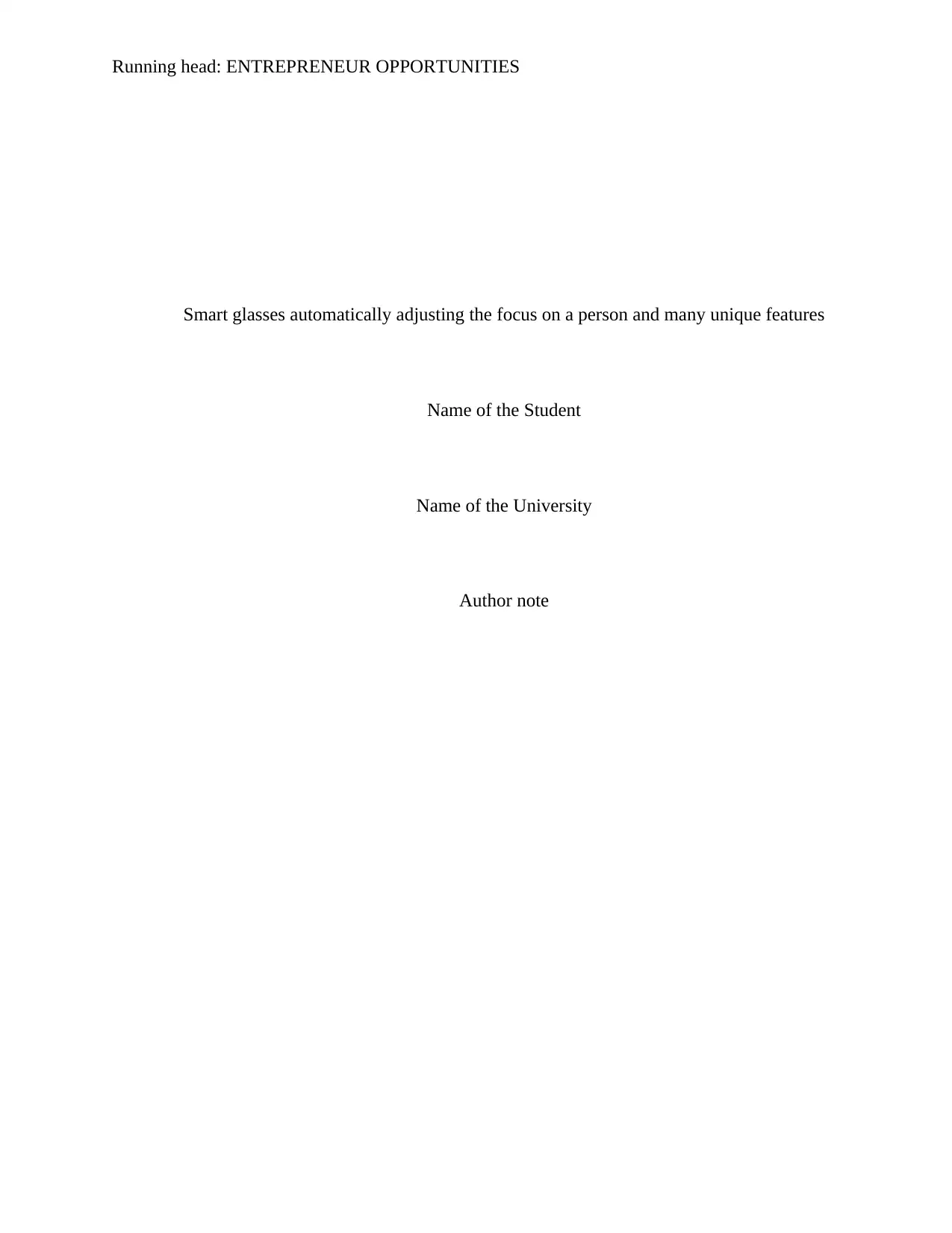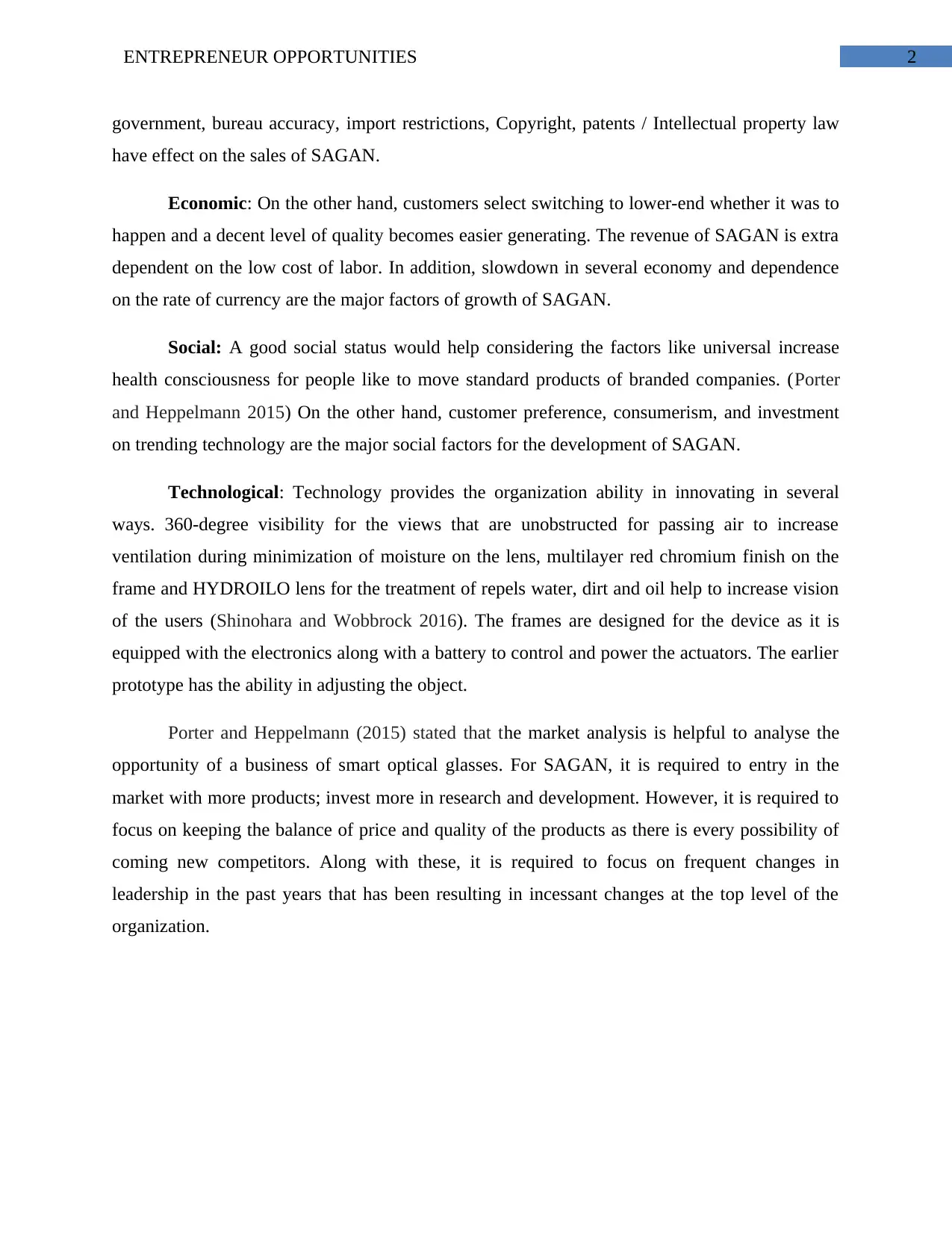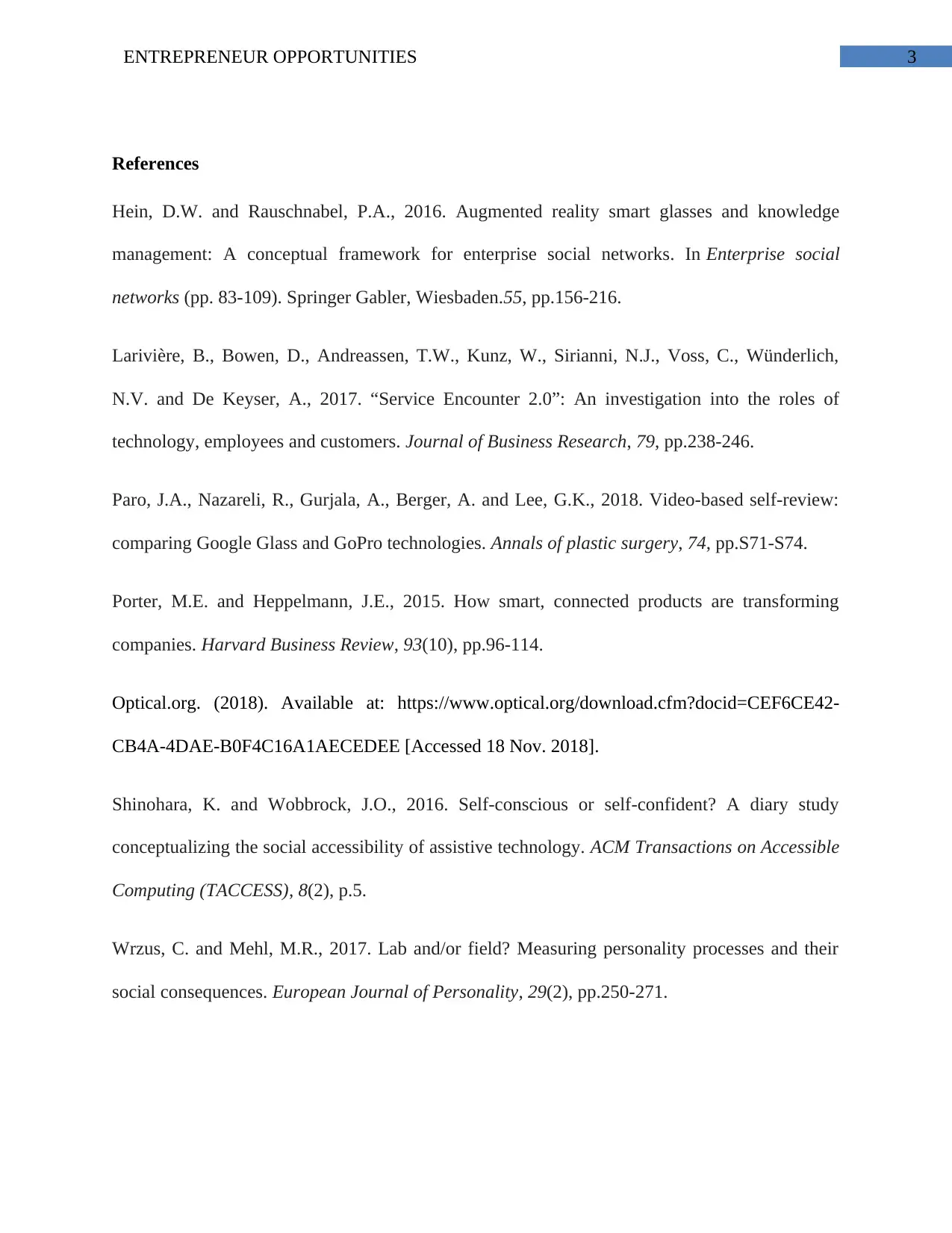QAB020N516A - Exploring Entrepreneurial Opportunities in Smart Glasses
VerifiedAdded on 2023/05/30
|4
|1154
|419
Report
AI Summary
This report assesses the entrepreneurial opportunities within the global smart glasses market, highlighting its growth, key trends, and potential challenges. The analysis includes a PESTLE framework, considering political, economic, social, and technological factors influencing the market. The report emphasizes the increasing demand for smart glasses in various applications and the potential for new entrants, while also acknowledging the uncertainties and competition. It also touches upon the importance of innovation, research and development, and maintaining a balance between price and quality to succeed in this evolving market. Desklib provides access to similar reports and solved assignments for students.

Running head: ENTREPRENEUR OPPORTUNITIES
Smart glasses automatically adjusting the focus on a person and many unique features
Name of the Student
Name of the University
Author note
Smart glasses automatically adjusting the focus on a person and many unique features
Name of the Student
Name of the University
Author note
Paraphrase This Document
Need a fresh take? Get an instant paraphrase of this document with our AI Paraphraser

1ENTREPRENEUR OPPORTUNITIES
The global smart glasses market is one of the emerging products in the market. It has
been reported that the market size of smart glasses has increased at a CAGR of 42.87% during
2018-2022 (Paro et al. 2018). One of the trends in the market is scope for varied players to
venture in to smart glasses market (Hein and Rauschnabel 2016). On the other hand, the
conventional eyewear manufacturers manufacture the variables that are targeted for sports
person’s use. The smart glasses are different from traditional glasses that consider additional
functionalities that are processed. The smart glasses include sensors as well as wireless
technology connected to several smart wearables as well as devices like smartphones and
watches. It has been reported that the revenue market in the eyewear market amounts Wrzus and
Mehl (2017) mentioned that despite the increase of cost, people spends more on optical products.
In 2008, 2.55 billion euro spent on optical goods as well as services compared to 2.82 billion
euro in 2013 and 2.93 billion euro in 2014. The trend shows that there is an increase of optical
markets in the UK in upcoming years. In 2010, the independents had nearly 40% of the UK
market, whereas in 2013the figure dropped to 28% (Optical.org 2018). However, it remained
steady in 2015 at 29%. Hence, it proves the market is increasing every day because of increasing
the eye issues of people.
One of the drivers in the market is operation automation. The procedure of automation in
the manufacturing industry is minimizing the requirement of human labor. The World Economic
Forum 2016 held at Switzerland indicated the fourth industrial revolution that will be based on
entire automated industry. However, one of the challenges in the market is uncertain market
conditions. Specific pessimistic aspects to smart glasses market are one of the factors involved
with the process. The key market trend has been identified as scope for varied players to the
ventures into smart glasses market, patenting of technology, development of AR platforms
(Larivière et al. 2017). Focusing on the factor of utility and adoption of gesture recognition in
smart glasses are also considered as the key market trends. The development of the market is
driven through the factors like increasing demand for the smart glass in the applications.
Political: The global smart glass has developed in a significant way and expected to
develop more in upcoming days (Wrzus and Mehl 2017). Brexit- the UK to leave the European
Union is one of the major issues that has impact on the sales of SAGAN. In addition, stability of
The global smart glasses market is one of the emerging products in the market. It has
been reported that the market size of smart glasses has increased at a CAGR of 42.87% during
2018-2022 (Paro et al. 2018). One of the trends in the market is scope for varied players to
venture in to smart glasses market (Hein and Rauschnabel 2016). On the other hand, the
conventional eyewear manufacturers manufacture the variables that are targeted for sports
person’s use. The smart glasses are different from traditional glasses that consider additional
functionalities that are processed. The smart glasses include sensors as well as wireless
technology connected to several smart wearables as well as devices like smartphones and
watches. It has been reported that the revenue market in the eyewear market amounts Wrzus and
Mehl (2017) mentioned that despite the increase of cost, people spends more on optical products.
In 2008, 2.55 billion euro spent on optical goods as well as services compared to 2.82 billion
euro in 2013 and 2.93 billion euro in 2014. The trend shows that there is an increase of optical
markets in the UK in upcoming years. In 2010, the independents had nearly 40% of the UK
market, whereas in 2013the figure dropped to 28% (Optical.org 2018). However, it remained
steady in 2015 at 29%. Hence, it proves the market is increasing every day because of increasing
the eye issues of people.
One of the drivers in the market is operation automation. The procedure of automation in
the manufacturing industry is minimizing the requirement of human labor. The World Economic
Forum 2016 held at Switzerland indicated the fourth industrial revolution that will be based on
entire automated industry. However, one of the challenges in the market is uncertain market
conditions. Specific pessimistic aspects to smart glasses market are one of the factors involved
with the process. The key market trend has been identified as scope for varied players to the
ventures into smart glasses market, patenting of technology, development of AR platforms
(Larivière et al. 2017). Focusing on the factor of utility and adoption of gesture recognition in
smart glasses are also considered as the key market trends. The development of the market is
driven through the factors like increasing demand for the smart glass in the applications.
Political: The global smart glass has developed in a significant way and expected to
develop more in upcoming days (Wrzus and Mehl 2017). Brexit- the UK to leave the European
Union is one of the major issues that has impact on the sales of SAGAN. In addition, stability of

2ENTREPRENEUR OPPORTUNITIES
government, bureau accuracy, import restrictions, Copyright, patents / Intellectual property law
have effect on the sales of SAGAN.
Economic: On the other hand, customers select switching to lower-end whether it was to
happen and a decent level of quality becomes easier generating. The revenue of SAGAN is extra
dependent on the low cost of labor. In addition, slowdown in several economy and dependence
on the rate of currency are the major factors of growth of SAGAN.
Social: A good social status would help considering the factors like universal increase
health consciousness for people like to move standard products of branded companies. (Porter
and Heppelmann 2015) On the other hand, customer preference, consumerism, and investment
on trending technology are the major social factors for the development of SAGAN.
Technological: Technology provides the organization ability in innovating in several
ways. 360-degree visibility for the views that are unobstructed for passing air to increase
ventilation during minimization of moisture on the lens, multilayer red chromium finish on the
frame and HYDROILO lens for the treatment of repels water, dirt and oil help to increase vision
of the users (Shinohara and Wobbrock 2016). The frames are designed for the device as it is
equipped with the electronics along with a battery to control and power the actuators. The earlier
prototype has the ability in adjusting the object.
Porter and Heppelmann (2015) stated that the market analysis is helpful to analyse the
opportunity of a business of smart optical glasses. For SAGAN, it is required to entry in the
market with more products; invest more in research and development. However, it is required to
focus on keeping the balance of price and quality of the products as there is every possibility of
coming new competitors. Along with these, it is required to focus on frequent changes in
leadership in the past years that has been resulting in incessant changes at the top level of the
organization.
government, bureau accuracy, import restrictions, Copyright, patents / Intellectual property law
have effect on the sales of SAGAN.
Economic: On the other hand, customers select switching to lower-end whether it was to
happen and a decent level of quality becomes easier generating. The revenue of SAGAN is extra
dependent on the low cost of labor. In addition, slowdown in several economy and dependence
on the rate of currency are the major factors of growth of SAGAN.
Social: A good social status would help considering the factors like universal increase
health consciousness for people like to move standard products of branded companies. (Porter
and Heppelmann 2015) On the other hand, customer preference, consumerism, and investment
on trending technology are the major social factors for the development of SAGAN.
Technological: Technology provides the organization ability in innovating in several
ways. 360-degree visibility for the views that are unobstructed for passing air to increase
ventilation during minimization of moisture on the lens, multilayer red chromium finish on the
frame and HYDROILO lens for the treatment of repels water, dirt and oil help to increase vision
of the users (Shinohara and Wobbrock 2016). The frames are designed for the device as it is
equipped with the electronics along with a battery to control and power the actuators. The earlier
prototype has the ability in adjusting the object.
Porter and Heppelmann (2015) stated that the market analysis is helpful to analyse the
opportunity of a business of smart optical glasses. For SAGAN, it is required to entry in the
market with more products; invest more in research and development. However, it is required to
focus on keeping the balance of price and quality of the products as there is every possibility of
coming new competitors. Along with these, it is required to focus on frequent changes in
leadership in the past years that has been resulting in incessant changes at the top level of the
organization.
⊘ This is a preview!⊘
Do you want full access?
Subscribe today to unlock all pages.

Trusted by 1+ million students worldwide

3ENTREPRENEUR OPPORTUNITIES
References
Hein, D.W. and Rauschnabel, P.A., 2016. Augmented reality smart glasses and knowledge
management: A conceptual framework for enterprise social networks. In Enterprise social
networks (pp. 83-109). Springer Gabler, Wiesbaden.55, pp.156-216.
Larivière, B., Bowen, D., Andreassen, T.W., Kunz, W., Sirianni, N.J., Voss, C., Wünderlich,
N.V. and De Keyser, A., 2017. “Service Encounter 2.0”: An investigation into the roles of
technology, employees and customers. Journal of Business Research, 79, pp.238-246.
Paro, J.A., Nazareli, R., Gurjala, A., Berger, A. and Lee, G.K., 2018. Video-based self-review:
comparing Google Glass and GoPro technologies. Annals of plastic surgery, 74, pp.S71-S74.
Porter, M.E. and Heppelmann, J.E., 2015. How smart, connected products are transforming
companies. Harvard Business Review, 93(10), pp.96-114.
Optical.org. (2018). Available at: https://www.optical.org/download.cfm?docid=CEF6CE42-
CB4A-4DAE-B0F4C16A1AECEDEE [Accessed 18 Nov. 2018].
Shinohara, K. and Wobbrock, J.O., 2016. Self-conscious or self-confident? A diary study
conceptualizing the social accessibility of assistive technology. ACM Transactions on Accessible
Computing (TACCESS), 8(2), p.5.
Wrzus, C. and Mehl, M.R., 2017. Lab and/or field? Measuring personality processes and their
social consequences. European Journal of Personality, 29(2), pp.250-271.
References
Hein, D.W. and Rauschnabel, P.A., 2016. Augmented reality smart glasses and knowledge
management: A conceptual framework for enterprise social networks. In Enterprise social
networks (pp. 83-109). Springer Gabler, Wiesbaden.55, pp.156-216.
Larivière, B., Bowen, D., Andreassen, T.W., Kunz, W., Sirianni, N.J., Voss, C., Wünderlich,
N.V. and De Keyser, A., 2017. “Service Encounter 2.0”: An investigation into the roles of
technology, employees and customers. Journal of Business Research, 79, pp.238-246.
Paro, J.A., Nazareli, R., Gurjala, A., Berger, A. and Lee, G.K., 2018. Video-based self-review:
comparing Google Glass and GoPro technologies. Annals of plastic surgery, 74, pp.S71-S74.
Porter, M.E. and Heppelmann, J.E., 2015. How smart, connected products are transforming
companies. Harvard Business Review, 93(10), pp.96-114.
Optical.org. (2018). Available at: https://www.optical.org/download.cfm?docid=CEF6CE42-
CB4A-4DAE-B0F4C16A1AECEDEE [Accessed 18 Nov. 2018].
Shinohara, K. and Wobbrock, J.O., 2016. Self-conscious or self-confident? A diary study
conceptualizing the social accessibility of assistive technology. ACM Transactions on Accessible
Computing (TACCESS), 8(2), p.5.
Wrzus, C. and Mehl, M.R., 2017. Lab and/or field? Measuring personality processes and their
social consequences. European Journal of Personality, 29(2), pp.250-271.
1 out of 4
Your All-in-One AI-Powered Toolkit for Academic Success.
+13062052269
info@desklib.com
Available 24*7 on WhatsApp / Email
![[object Object]](/_next/static/media/star-bottom.7253800d.svg)
Unlock your academic potential
Copyright © 2020–2025 A2Z Services. All Rights Reserved. Developed and managed by ZUCOL.

